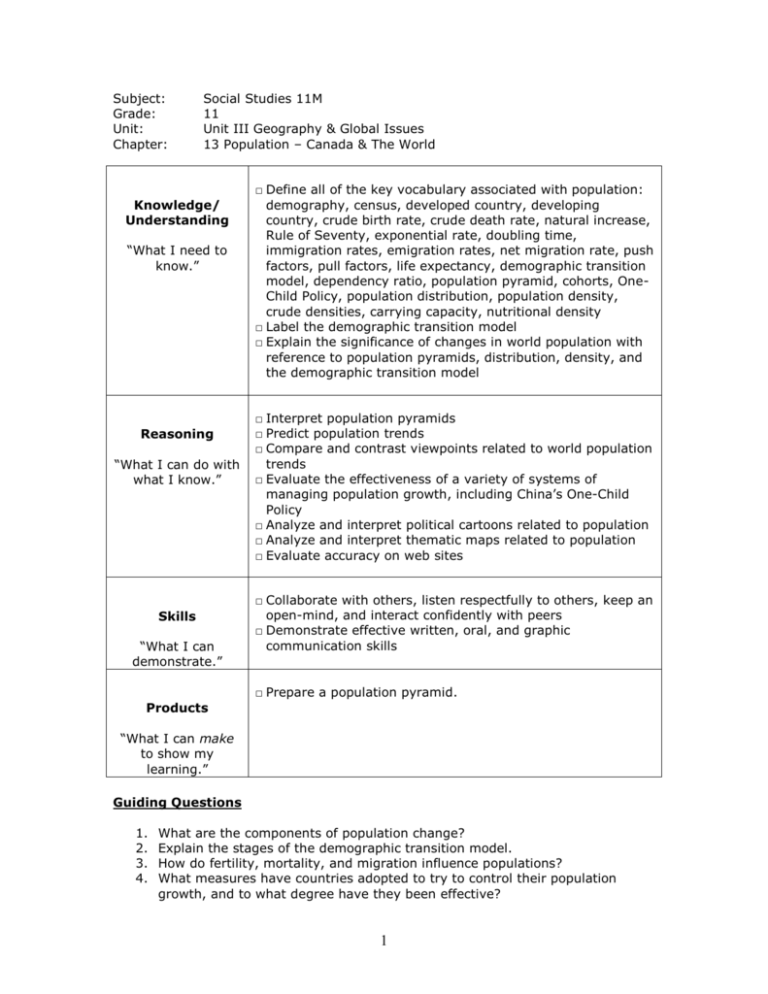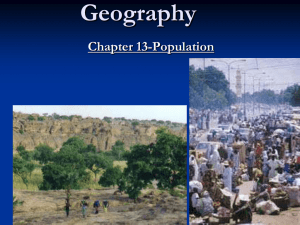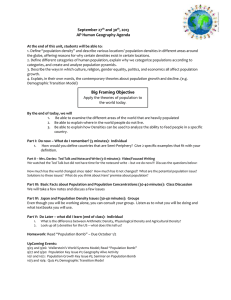13 Overview
advertisement

Subject: Grade: Unit: Chapter: Social Studies 11M 11 Unit III Geography & Global Issues 13 Population – Canada & The World Knowledge/ Understanding “What I need to know.” Reasoning “What I can do with what I know.” Skills “What I can demonstrate.” □ Define all of the key vocabulary associated with population: demography, census, developed country, developing country, crude birth rate, crude death rate, natural increase, Rule of Seventy, exponential rate, doubling time, immigration rates, emigration rates, net migration rate, push factors, pull factors, life expectancy, demographic transition model, dependency ratio, population pyramid, cohorts, OneChild Policy, population distribution, population density, crude densities, carrying capacity, nutritional density □ Label the demographic transition model □ Explain the significance of changes in world population with reference to population pyramids, distribution, density, and the demographic transition model □ Interpret population pyramids □ Predict population trends □ Compare and contrast viewpoints related to world population trends □ Evaluate the effectiveness of a variety of systems of managing population growth, including China’s One-Child Policy □ Analyze and interpret political cartoons related to population □ Analyze and interpret thematic maps related to population □ Evaluate accuracy on web sites □ Collaborate with others, listen respectfully to others, keep an open-mind, and interact confidently with peers □ Demonstrate effective written, oral, and graphic communication skills □ Prepare a population pyramid. Products “What I can make to show my learning.” Guiding Questions 1. 2. 3. 4. What are the components of population change? Explain the stages of the demographic transition model. How do fertility, mortality, and migration influence populations? What measures have countries adopted to try to control their population growth, and to what degree have they been effective? 1 5. Identify the different types of population pyramids. What does each type represent? 6. What is the dependency ratio and why is it important? 7. What effect does a young or aging population have on a country? 8. What problems are associated with population growth? 9. What is the difference between population distribution and density? 2 Subject: Grade: Unit: Chapter: Social Studies 11 11 Unit III Geography & Global Issues 14 Living Standards Knowledge/ Understanding “What I need to know.” Reasoning “What I can do with what I know.” Skills “What I can demonstrate.” Products “What I can make to show my learning.” 3 Subject: Grade: Unit: Chapter: Social Studies 11 11 Unit III Geography & Global Issues 15 Urbanization Knowledge/ Understanding “What I need to know.” Reasoning “What I can do with what I know.” Skills “What I can demonstrate.” Products “What I can make to show my learning.” 4 Subject: Grade: Unit: Chapter: Social Studies 11 11 Unit III Geography & Global Issues 16 Patterns in Economic Development Knowledge/ Understanding “What I need to know.” Reasoning “What I can do with what I know.” Skills “What I can demonstrate.” Products “What I can make to show my learning.” 5 Subject: Grade: Unit: Chapter: Social Studies 11 11 Unit III Geography & Global Issues 17 Environment Knowledge/ Understanding “What I need to know.” Reasoning “What I can do with what I know.” Skills “What I can demonstrate.” Products “What I can make to show my learning.” 6 Subject: Grade: Unit: Chapter: Social Studies 11 11 Unit III Geography & Global Issues 18 Looking Forward Knowledge/ Understanding “What I need to know.” Reasoning “What I can do with what I know.” Skills “What I can demonstrate.” Products “What I can make to show my learning.” 7







